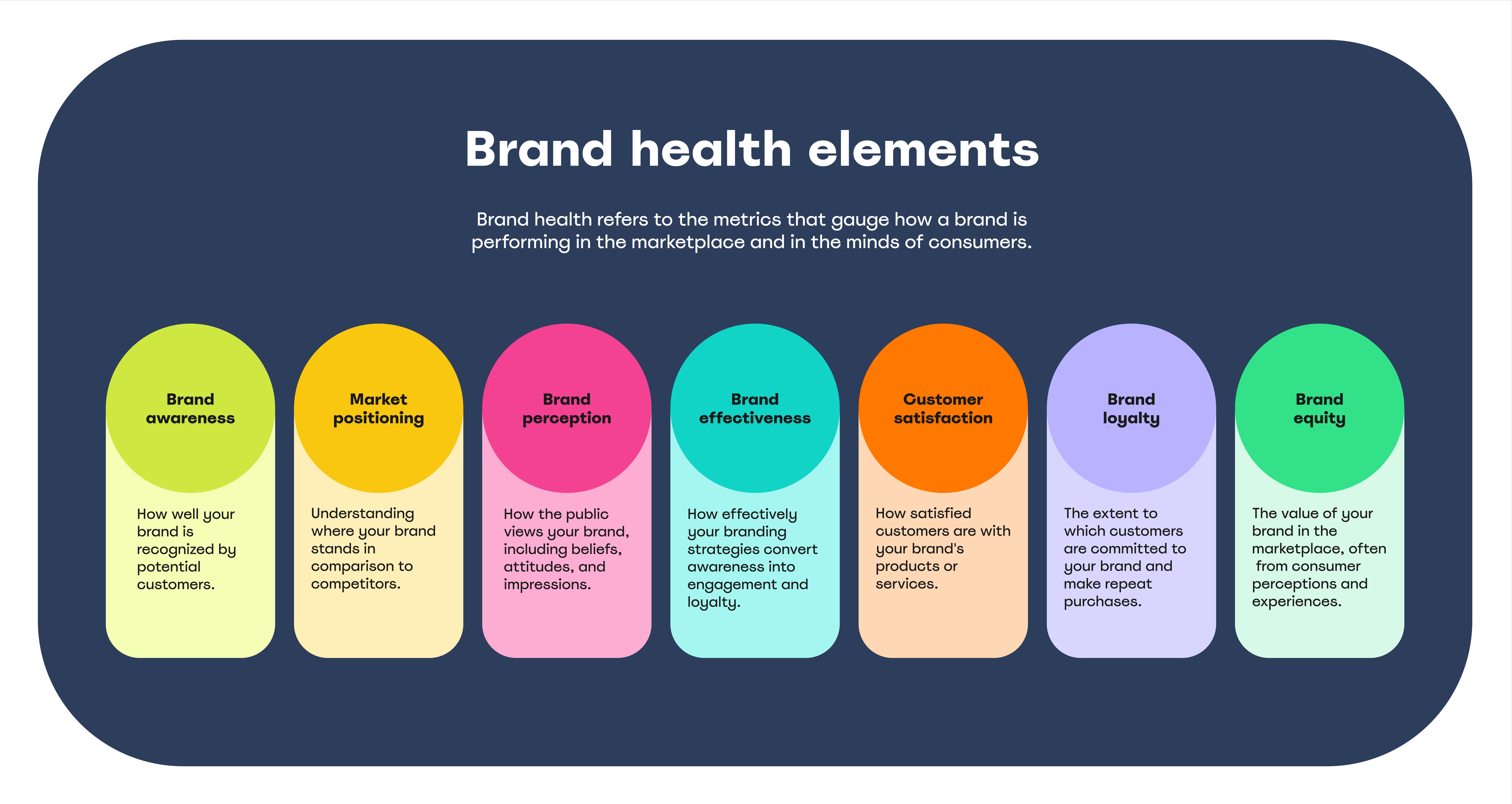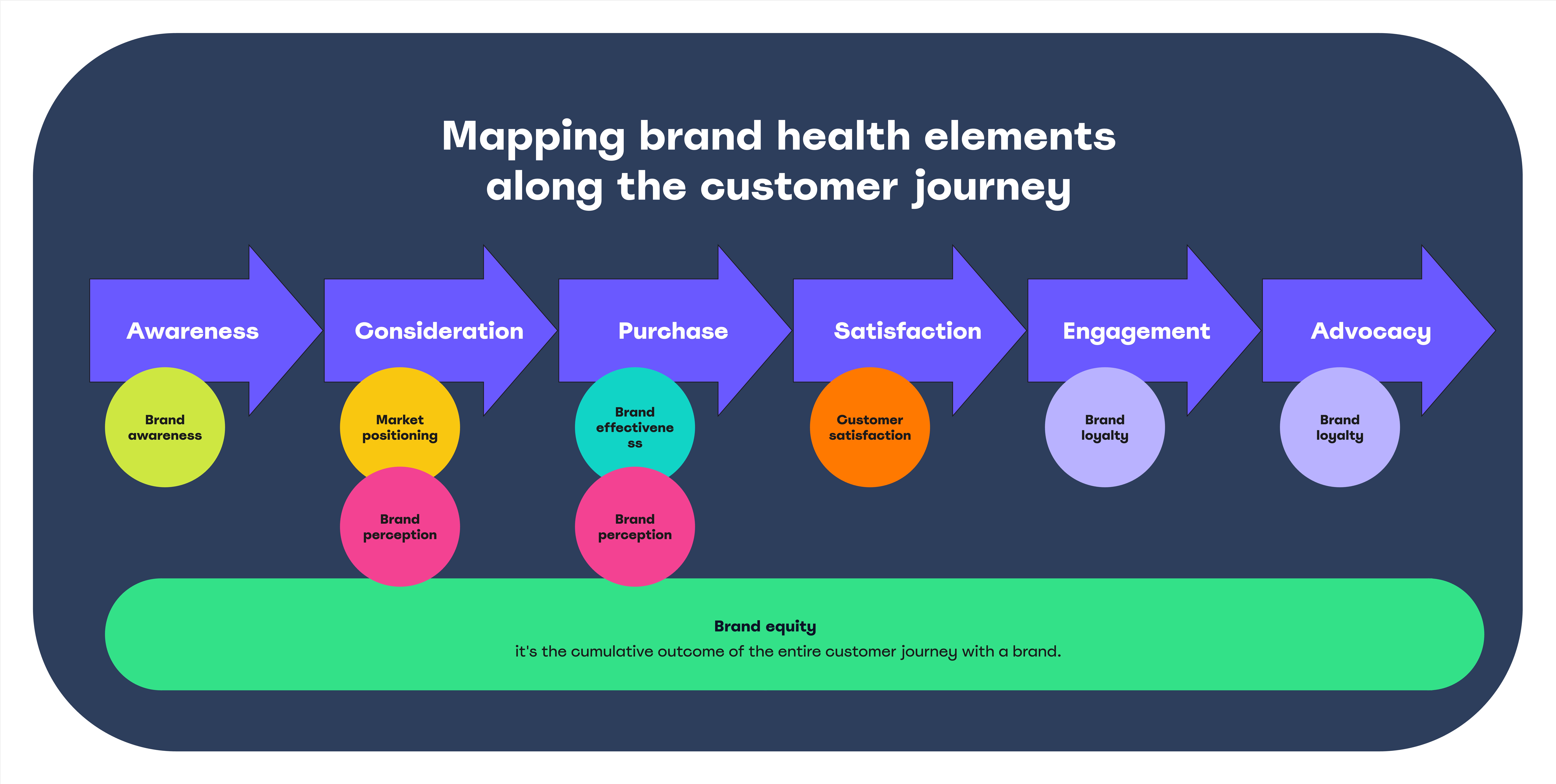What is brand health?
Brand health refers to how a brand is perceived in the market and by its customers. Measuring brand health is a multifaceted evaluation, similar to how a doctor assesses a person's health through various indicators. Measuring brand health helps businesses understand how strong and well-liked their brand is. This helps them know if they need to make improvements, just like how we might change our diet or exercise more if our health isn't great.
A healthy brand is strong in the market, popular among customers, and capable of achieving or exceeding strategic business objectives. Brand health is an indicator of a brand's vitality and potential for sustained success.
What elements makeup brand health?

Brand awareness: This is the starting point. It measures how well your brand is recognised by potential customers. If people are aware of your brand, they can consider it when making purchase decisions. It's critical to understand that consumers prefer the familiar, and they categorise new brands based on existing categories.
Market positioning: This is about understanding where your brand stands in comparison to competitors. It's related to brand awareness but focuses on your brand's unique place in the market. Good market positioning means that customers think of your brand in a way that sets it apart from others.
Brand perception: This takes into account how the public views your brand, including their beliefs, attitudes, and overall impressions. This is shaped by your marketing efforts and customer experiences. Brand perception is what people think when they hear your brand's name.
Brand effectiveness: This measures how effectively your branding strategies convert awareness into engagement and loyalty. It's about the impact of your marketing and whether it leads to customers choosing and sticking with your brand.
Customer satisfaction: This gauges how happy customers are with your products or services. High customer satisfaction often leads to repeat purchases and positive word-of-mouth, which in turn can enhance brand perception and loyalty.
Brand loyalty: This indicates the extent to which customers are committed to your brand and make repeat purchases. Loyal customers are less likely to switch to competitors and often become brand advocates.
Brand equity: This is the overall value of your brand in the marketplace, often derived from consumer perceptions and experiences. Strong brand equity is built on high awareness, positive perceptions, customer satisfaction, and loyalty.
These elements are interconnected key indicators a brand should take into account when measuring its health. It begins with awareness, which sets the foundation for market positioning. This positioning, if perceived positively, enhances the effectiveness of branding strategies. Successful strategies then lead to customer satisfaction. Once customers are satisfied, they often become loyal, contributing to the overall equity of the brand.
How do brand health metrics map out along the customer journey?

The indicators of brand health can be mapped along the customer journey stages. Here's how they align with each stage:
Awareness:
Brand Awareness: This is directly related to the awareness stage of the customer journey. It's about potential customers becoming aware of the brand's existence.
Consideration:
Market Positioning: In the consideration stage, consumers evaluate where your brand stands among the options available.
Brand Perception: Also crucial at this stage, as consumers are considering what they think and feel about your brand.
Purchase:
Brand Effectiveness: This reflects how well your brand has converted awareness and consideration into an actual purchase.
Brand Equity: The perceived value of your brand can be a deciding factor for consumers when they are making a purchase decision.
Satisfaction:
Customer Satisfaction: After purchase, this element assesses how pleased customers are with their experience and the product or service quality.
Engagement:
Brand Loyalty: Engaged customers are those who have a repeated positive interaction with the brand, leading to loyalty.
Brand Equity: High brand equity can encourage and enhance customer engagement.
Advocacy:
Brand Loyalty: Loyal customers are more likely to advocate for the brand.
Brand Equity: Strong brand equity often results in higher levels of advocacy as customers share their positive perceptions and experiences.
Some elements span multiple stages:
Brand perception affects consideration, purchase, and can even extend to satisfaction and engagement, as it is an evolving construct based on each interaction with the brand.
Brand equity is built throughout all stages, from awareness to advocacy, as it's the cumulative outcome of the entire customer journey with a brand.
How can brand health indicators be measured?
Measuring the health of a brand requires a systematic approach to data collection and analysis. Each indicator of brand health represents a specific facet of your brand's presence in the market and in the minds of consumers. Let’s have a look at the practical methods and tools that can help you capture these metrics effectively.
Choosing what to measure
In determining the health of your brand, focus on metrics that reflect your company's core objectives. If brand visibility is your aim, prioritize awareness metrics. For customer retention, look closely at satisfaction and loyalty indices. It's not about tracking every metric, but the right ones that inform your strategy and drive meaningful action. Select metrics that not only illuminate performance but also guide decision-making for sustainable growth.
Understanding measurement tools
A wide range of tools is available for assessing brand health. These include surveys, social media monitoring tools, financial analyses, and customer feedback platforms. Choosing the appropriate tool for each specific metric is crucial. For example, to measure brand awareness, you might use brand recall surveys. Similarly, customer satisfaction can be gauged using Net Promoter Scores (NPS) or Customer Satisfaction (CSAT) surveys.
Setting benchmarks
Setting benchmarks for brand health is like marking a starting line for a race. It helps you know where you began so you can see how far you've come later. First, decide what you want to measure, like how well-known your brand is or how many people buy your product. Think of these benchmarks as checkpoints in a race. By regularly checking them, you can see if your brand is doing well, find out what needs to get better, and keep track of your progress over a certain period. This makes it easier to make good decisions and adjust your strategies to stay on track towards your goals. Benchmarks are not just a snapshot of where your brand is now; they're a map of where it needs to go.
Need help boosting your brand’s health?
Unsure about where to start in assessing your brand’s health? Begin with a foundational yet key step: pinpoint the most vital indicator of your brand's health aligned with your current business objectives. Are you aiming to increase brand awareness, enhance customer satisfaction, or strengthen customer loyalty? Identifying and focusing on the right brand health metric allows you to focus your efforts in a direction that will bring you closer to your goals.
Ready to embark on this journey with your brand? At Fruto we're here to guide you in navigating the landscape of brand health. Reach out to us! We’d love to hear about your brand and help you gain a comprehensive view of where your brand stands and how to strategically improve its presence in the market.





